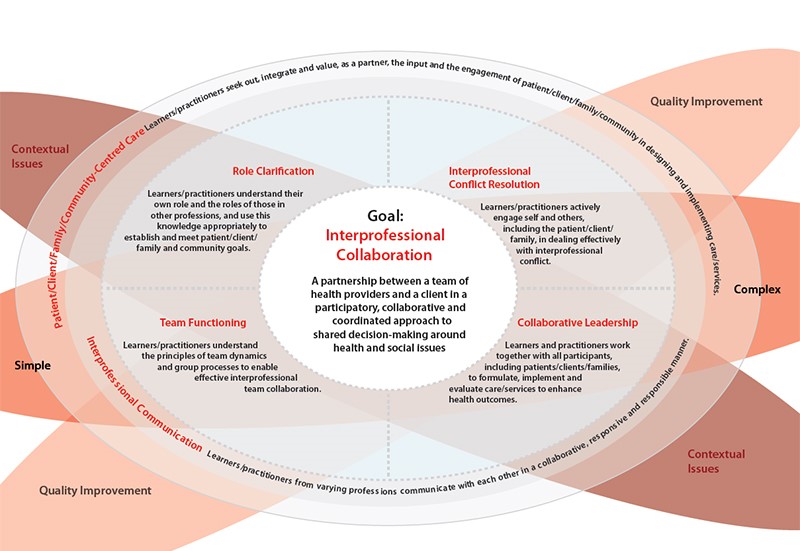9.1 Interprofessional Communication and Collaboration
Learning Objectives
- Explain the relevance of interprofessional communication within interprofessional collaboration.
- Describe the National Interprofessional Competency Framework
- Summarize the principles and strategies of interprofessional communication.
Interprofessional communication involves verbal, written, and nonverbal communication. Verbal communication may include conversations between two or more interprofessional team members, usually in person.
Written communication in the interprofessional context commonly includes documentation notes in a client’s chart, such as progress notes, physician orders, medication administration records, diagnostic reports, referral letters, and discharge notes. Other examples may include faxes and emails, and text messages.
Finally, nonverbal communication in the interprofessional context involves meaning and interpretation conveyed through body language such as facial expressions, eye contact, body position, and gestures. Awareness of your body language and ensuring it aligns with your verbal language is essential.
Effective interprofessional collaboration fosters effective teamwork among members of an interprofessional client care team to optimize client outcomes (Canadian Interprofessional Health Collaborative (CIHC), 2010), ensuring that clients are safe throughout the health care system (Canadian Nurses Association, n.d.).
Because of the significance of interprofessional collaboration, the Canadian Interprofessional Health Collaborative (CIHC) has developed a National Interprofessional Competency Framework, as shown below.

Six interdependent competency domains have been identified to achieve the goal of interprofessional collaboration (CIHC, 2010). These are defined as the “knowledge, skills, attitudes, and values that shape the judgements essential for interprofessional practice” (CIHC, 2010, pg. 9) and include:
- Interprofessional communication
- Patient/client/family/community-centred care
- Role clarification
- Team functioning
- Interprofessional conflict resolution
- Collaborative leadership
The first two competencies have a vital influence in all healthcare situations, so as shown in the figure, they encircle the other four competencies. This framework can assist you in contributing to an effective healthcare team functioning with a focus on communication and working together collaboratively.
The competency domain of interprofessional communication is central to interprofessional collaboration because it supports the other five competency domains (CIHC, 2010).
To fulfill the interprofessional communication competency, nurses and all health care professionals must develop the capacity to “communicate with each other in a collaborative, responsive and responsible manner” (CIHC, 2010, p. 16). This means that each healthcare professional is responsible for engaging in effective communication in the specific clinical and interprofessional context respectfully, explicitly, and transparently (Lyndon et al., 2011). It is essential to actively respond to the perspectives of everyone involved, including the client and other healthcare professionals. Following are some strategies for effective interprofessional communication, adapted from the CIHC (2010).
|
Descriptors |
Explanation |
|
“Establish teamwork communication principles” (p.16). |
Explanation: A clear set of communication principles and procedures is essential for healthcare teams that work closely and depend on each other. These principles and procedures can foster open and creative discussions, recognition and appreciation of each person’s role and contribution, and transparency in decision-making. |
|
“Actively listen to other team members” (p. 16). |
Explanation: Active listening involves closely attending to what another person is saying and responding to them based on what they said. |
|
“Communicate to ensure common understanding of care decisions” (p. 16). |
Explanation: Each health care professional is responsible for communicating and clarifying discussions, changes in client condition, reasons for those changes or clarifying a written order or client care plan when it is unclear. |
|
“Develop trusting relationships with clients/families and other team members” (p. 16). |
Explanation: Trust among the healthcare team (including clients/families) is integral to communication. Part of building trust begins with your interactions with each other. It is essential to engage with others in respectful ways and provide time for discussion. Additionally, it is essential to be honest in your communication. You should aim to be knowledgeable on the topic, and if you are not, open up the discussion in a way that addresses this and allows for a learning opportunity. |
|
“Effectively use information and communication technology to improve interprofessional client/community-centred care” (p. 16). |
Explanation: Information and communication technology involving telephone, computers, and software programs can facilitate communication. You will commonly use computer-based documentation systems to document your assessments and plans of care. You must document clearly and follow your profession’s Documentation Standards of Practice. |
Consistent execution of successful communication requires attentive listening skills, administrative support, and collective commitment (Lyndon et al., 2011). Other principles of interprofessional communication include:
- Speak clearly with appropriate vocal intonation and at a moderate pace
- Keep It Simple and Straightforward (K.I.S.S. method)
- Maintain eye contact and show confidence in what you are saying
- Be efficient in your communication
- Incorporate adequate, relevant, and timely information
- Engage in active listening and ask questions for clarification
- Speak up and seek clarification until your concern regarding a client is addressed
- Put clients first: always remember (and if appropriate, remind your interprofessional team members) that your decisions and actions affect the client; the client should be the focus of your discussions
Activity: Check Your Understanding
Key Takeaways
- Interprofessional communication occurs between members of various professions, including the client/family.
- Interprofessional communication is a fundamental component of interprofessional collaboration and optimizing client outcomes.
- Effective interprofessional communication and collaboration enhance client outcomes.
- The Canadian Interprofessional Health Collaborative has developed a National Interprofessional Competency Framework comprised of six interdependent competency domains.
Exercises
References
Canadian Interprofessional Health Collaborative. (2010). A national interprofessional competency framework. https://phabc.org/wp-content/uploads/2015/07/CIHC-National-Interprofessional-Competency-Framework.pdf
Canadian Nurses Association. (n.d.). Position statement – Interprofessional collaboration. https://www.cna-aiic.ca/en/nursing/nursing-tools-and-resources/interprofessional-collaboration
Lyndon, A., Zlatnik, M., & Wachter, R. (2011). Effective physician-nurse communication: A patient safety essential for labor & delivery. American Journal of Obstetrics & Gynecology, 205(2), 91–96. https://doi.org/10.1016/j.ajog.2011.04.021
Image Attributions
Figure 9.1.1 Canadian Interprofessional Health Collaborative. (2010). A national interprofessional competency framework https://phabc.org/wp-content/uploads/2015/07/CIHC-National-Interprofessional-Competency-Framework.pdf
Attribution Statement
Content adapted, with editorial changes, from:
Lapum, J., St.-Amant, O., Hughes, M., Garmaise-Yee, J., & Lee, C. (2020). Professional communication in health professions [Adapted]. Toronto Metropolitan University Pressbooks. https://pressbooks.nscc.ca/healthcommunication/
Licensed under a Creative Commons Attribution-NonCommercial-ShareAlike 4.0 International License, except where otherwise noted.


